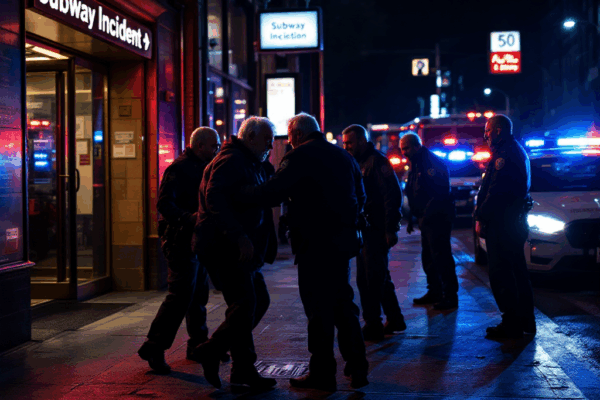Flames Erupt in the Heart of the City: The Shocking Morning of the Line 5 Subway Fire
On a busy morning commute, flames suddenly blaze inside the subway—how would you respond? Follow the harrowing story behind the fire that struck Seoul’s very core.
On May 31, 2025, what began as an ordinary morning took a tragic turn aboard Seoul Subway Line 5. Between Yeouinaru and Mapo stations, fire erupted unexpectedly inside a moving train, instantly engulfing passengers in fear and chaos.
At 8:43 a.m., the emergency call from a passenger marked the start of what became known nationwide as the “Line 5 Fire.” A man believed to be in his 60s had attempted arson using a container of fuel and a lighter-style torch. The moment fuel splattered in the confined subway car and flames ignited, terror reached its peak among those aboard.
Yet amidst the crisis, the courage of ordinary citizens shone brightly. Despite panic, some passengers sprang into action immediately. Using fire extinguishers installed on the train, they managed to suppress the flames early on, a critical effort that prevented a major disaster.
A charred mask photo shared alongside social media posts titled “Escaping the Line 5 Fire” vividly conveyed the severity of the scene. Inside the smoke-filled train, passengers fought desperately to evacuate, and thankfully, the incident concluded with no major casualties.
This Line 5 fire raises vital questions: How safe are our public transit systems that support daily life? How should we react in emergencies? What measures must be taken to prevent future incidents?
While the shocking morning has passed, the challenges facing our society remain. Let the Line 5 fire serve as a catalyst for building safer cities and stronger communities.
Revealing the Timeline: Minute-by-Minute Progression of the Line 5 Fire Incident
A relentless series of urgent moments unfolded within just 90 minutes! Reported at 8:43 AM, suspect arrested at 9:45 AM, full recovery by 10:10 AM—what exactly transpired among passengers, police, and firefighters during this brief span? Let’s reconstruct the gripping timeline of the Line 5 fire incident minute by minute.
08:43 – The Fateful Moment, Fire Reported
- A sudden fire breaks out inside the train at Mapo Station
- Passengers’ panicked cries lead to an emergency report
- Station staff swiftly begin initial response efforts
08:50 – Arsonist’s Malicious Act, Passengers’ Courage
- A man in his 60s attempts deliberate arson using a fuel can and torch
- Brave passengers grab fire extinguishers to suppress the flames early on
- Smoke rapidly spreads inside the train, evacuation orders issued
09:00 – Emergency Rescue Teams Arrive on Scene
- Fire trucks and ambulances wail their sirens around the station
- 74 pieces of equipment and 263 personnel quickly deployed
- Passenger evacuation and fire suppression proceed simultaneously
09:20 – Full Suspension Between Yeouido and Aeogae Stations
- Operations halted on part of Line 5
- Guidance on alternative routes begins for nearby station passengers
- Real-time updates circulate on social media, heightening public anxiety
09:45 – Suspect Finally Apprehended
- Police successfully arrest the man in his 60s at Yeouinaru Station
- Fuel can, torch, and other evidence seized
- Passengers breathe sighs of relief, yet tension remains high
10:10 – Fire Incident Concluded, Service Resumes
- Fire authorities declare complete extinguishment of the blaze
- Train operations normalized between Yeouido and Aeogae Stations
- Passengers return to their daily routines, though trauma lingers
What does this intense 90-minute ordeal reveal to us? It vividly underscores the critical importance of rapid crisis response and citizens’ cooperation, while highlighting how swiftly everyday life can be thrust into peril. Though the Line 5 fire brought the beating heart of Seoul’s capital to a halt, it also became a crucial test of our society’s emergency preparedness and resilience.
On the Frontlines of Emergency Response to the Line 5 Subway Fire: Citizens and Public Forces Fiercely Guarding Safety
Ordinary citizens extinguished the fire with fire extinguishers, while police and firefighters stood armed to protect the station. With 74 pieces of equipment and 263 personnel—what truly quelled the subway chaos so swiftly?
The Seoul Subway Line 5 fire incident was a scene where citizens’ courage and the swift response of public agencies combined to prevent a major disaster. Immediately after the fire broke out, passengers remained composed despite the urgent situation. They quickly used the fire extinguishers installed on the train to suppress the initial flames, playing a decisive role in preventing greater damage.
At the same time, public agencies acted promptly. Fire authorities deployed a massive operation as soon as the fire was reported. With 74 specialized firefighting vehicles and 263 experts rushed to the scene, they carried out systematic fire suppression and passenger evacuation efforts. This large-scale mobilization was key in stopping the fire from spreading and ensuring passenger safety.
The police also took immediate action. Rapid response patrol units were stationed at Yeouinaru and Mapo Stations to block additional risks and protect citizens. This multi-faceted response contributed to restoring subway operations to normal within about two hours of the fire’s outbreak.
The Line 5 fire incident stands as a testament to citizens’ bravery, public agencies’ rapid response, and the readiness of safety systems working in harmony to avert a catastrophic disaster. It served as a powerful reminder of the critical importance of everyday safety education, training, and facility management.
If this cooperative framework continues to be strengthened and citizens’ safety awareness raised, we can build an even safer public transportation environment. Although the Line 5 fire incident has ended, the efforts from all of us toward safety must persist.
Social Impact and Live Streaming on SNS: Passengers’ Cries Amid the Line 5 Subway Fire
The Line 5 subway fire incident spread rapidly across social media. A photo of a pitch-black charred mask posted by a passenger swept through online communities, vividly conveying the gravity of the incident. The post titled “Escape from Line 5 Fire” struck a chord with countless netizens, evoking empathy and concern.
This single photo held deeper significance beyond being just an image. The burnt mask symbolized the terror and danger passengers faced, while simultaneously sounding an alarm about our society’s safety awareness.
Real-time testimonies shared via SNS accelerated the spread of information about the incident:
- Vivid eyewitness accounts from the scene
- Shared chaos and confusion during evacuation
- Urgent messages alerting family and friends to safety
The role of social media proved crucial in rapidly conveying the seriousness of the incident to the public. However, it also came with the drawback of spreading inaccurate information.
The Line 5 fire significantly heightened safety anxieties among subway riders. This incident occurring in everyday public transportation instilled the realization, “I too could become a victim.”
As a result, citizens’ safety consciousness has grown:
- Locating emergency exits
- Learning how to use fire extinguishers
- Familiarizing themselves with protocols for emergencies
Ultimately, the Line 5 fire incident sparked a surge of social attention toward public transportation safety. Along with improved safety awareness among citizens, it prompted authorities to enhance security measures. The ripple effect caused by one single photo of a charred mask powerfully demonstrated just how sensitively our society reacts to issues of safety.
New Challenges in Subway Safety: What Must Change After the Line 5 Fire?
This is a question we cannot simply dismiss as a single incident. Harsher punishment for arsonists, enhanced fire detection systems, expanded public education—if you were a passenger today, what changes do you believe are necessary for tomorrow?
The Line 5 fire incident has awakened our society to the urgent need for heightened subway safety awareness. Now, we must reflect on what efforts are required to create a safer subway environment in the wake of this event.
- Strengthening Security to Prevent Arson
- Expanding CCTV coverage in subway stations and cars
- Introducing AI-based abnormal behavior detection systems
- Reinforcing screening procedures to block hazardous materials
- Improving Fire Response Systems
- Installing the latest fire detection sensors and automatic extinguishing systems
- Enhancing emergency exits and evacuation guidance systems
- Conducting regular fire response drills for station staff and crew
- Raising Public Safety Awareness
- Expanding safety education programs for subway riders
- Strengthening campaigns on how to act during emergencies
- Introducing citizen-participatory safety monitoring programs
- Legal and Institutional Improvements
- Toughening penalties for arson and dangerous acts within subways
- Increasing and professionalizing subway safety management personnel
- Expanding safety budgets and ensuring their efficient use
While the Line 5 fire shocked us deeply, it also opened a window for transformative change toward a safer future. If passengers, operators, and policymakers unite to tackle these challenges, we can build a subway system that is safer and more trustworthy than ever.
What do you think? For the subway that safeguards our daily lives, what can each of us do to ensure its safety? Reflecting and taking action together is the new challenge before us all.




